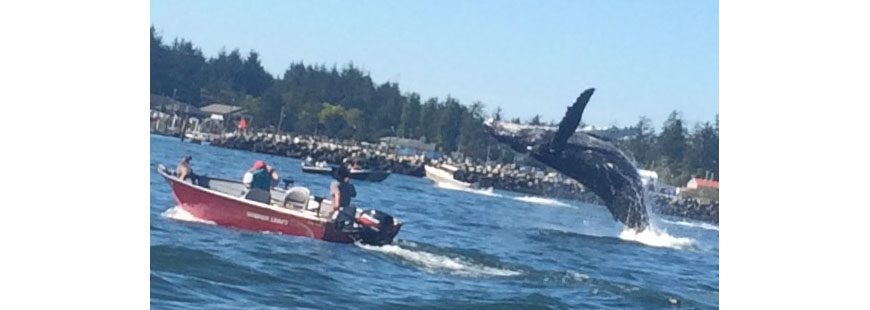Breaching humpback whale in front of the Hammond Boat Basin in mid-August of 2016. How ironic is it that this was the site where Free Willy was filmed, jumping over the very jetty seen in the background here?
It’s been over a year now since the Marine Fish Conservation Network began broadcasting our blog posts under their “From the Waterfront” section of their website and to our social media outlets. It’s been fun to write and even more rewarding getting feedback from our readers of The Guide’s Forecast newsletter. We appreciate hearing from you and we’re glad to be able to bring you our perspective on how our ocean ecosystems are performing. I often worry about “writer’s block,” or when I’ll run out of things to say or worse yet, when I’ll start repeating myself. Thankfully, the dynamics of our aquatic ecosystems, whether fresh or saltwater, offers up plenty of subject matter these days, and that may not be such a good thing.
It’s definitely transition time on the North Oregon Coast. The water and air temperatures are starting to drop, and even just a few degrees makes a big difference. For the first time this season, fishing downstream of Hammond, Oregon’s most Northwesterly city, water temperatures dipped below 60 degrees. It’s been another hot water summer, and it seems to have made a difference.
With the drop in temperatures, I’ve taken notice of several things:
- Swaths of anchovies that twitched our lines because they were so thick, are now very sparse in the river; that seemed to happen virtually overnight.
- Since the anchovies are gone, so are the whales. A rare sighting of whales in the river is an anomaly in and of itself, but some of the spectacular behavior we saw this summer was stunning!
- Fish are more “bitey!” The fish seemed to have been there all along, just not so willing to bite. Action for coho and Chinook has recently improved. Our catch rates have been so low that we just got a season extension for Chinook, through September 14th. While this is of course good news, it happened for a reason, because we grossly under harvested our allocation.
- Jellyfish are less problematic and seaweed is a bit more prevalent.
- With the baitfish gone, the seagulls have all of a sudden become more aggressive. You have to watch for how long you have your bait near the surface, these birds are hangry and aggressive. I’ve witnessed this behavior in pelicans, when all the baitfish start to sound to deeper water, out of reach for those that dive from the surface.
- I’ve never seen shearwaters in the lower Columbia River before, at least not to my recollection. They typically stick to the ocean, where there are abundant food resources for them.
These are just the changes I’ve noticed, practically overnight. Just a slight change in temperature can produce a drastic change in fish and wildlife behavior. We’re still weeks away from the official beginning of fall, but things are a changin’. Has anyone else’s leaves started to fall from their trees?
I’m also changing gears; switching from a less-than-productive Buoy 10 season on the lower Columbia to hopefully a good fall Chinook season on Tillamook Bay. The fall fish are starting to show in Tillamook and a good handful of other coastal estuaries. This is the swan song of summer, before we see all critters prepare for the lean season.
It won’t be long either, until I head back to my job at the Association of Northwest Steelheaders, where I switch from harvesting fish, to protecting them. It’s become an enjoyable 10-month “season” out of my year, and it seems like a job that will never end. I’ll get my finger on the pulse for how our policy makers feel about fish conservation, trips to Washington DC, the long session in Salem, our state’s capitol, and hopefully forward movement on issues that matter to fishermen the most. It seems every year is more important than the previous, every year we’re fighting harder to keep our heritage intact.
This might be the time of year where you research your role in the future of our fisheries. Volunteering for an organization can be a very rewarding thing. There are river clean-ups, salmon carcass tosses, Family Fish Camp and certainly engaging with your legislator on how you feel about laws that aid fish and wildlife.
The Association of Northwest Steelheaders proudly donates around 30,000 volunteer hours each year to the betterment of our fisheries. One of our key volunteers recently got recognized by The Oregonian’s Bill Monroe. Bill wrote a great article about Art Israelson and the incredible work he does for fisheries. A volunteer like Art only comes around once in a blue moon, but thankfully, our Association has a team of Art Israelsons, and so do many other non-profits.
One of the key laws we’ll be fighting for is the reauthorization of the Magnuson-Stevens Act. It’s the federal fisheries law that protects our fisheries from overharvest, amongst other important provisions. We’ll keep you informed as to how this progresses and what role sport anglers can have in the reauthorization of this law. You’ve certainly read a lot about how important our forage fish are to the health of our fisheries. The Magnuson-Stevens Act, and even our state laws, will decide the future for these little fish that are a big deal. You saw another Steelheaders super-hero, Norm Ritchie, at bat for fishermen at the Oregon Fish and Wildlife Commission, fighting for protections of forage fish in our state waters at meeting in Welches on Friday, September 2nd. Come along for the ride, it’s going to be a great winter!


